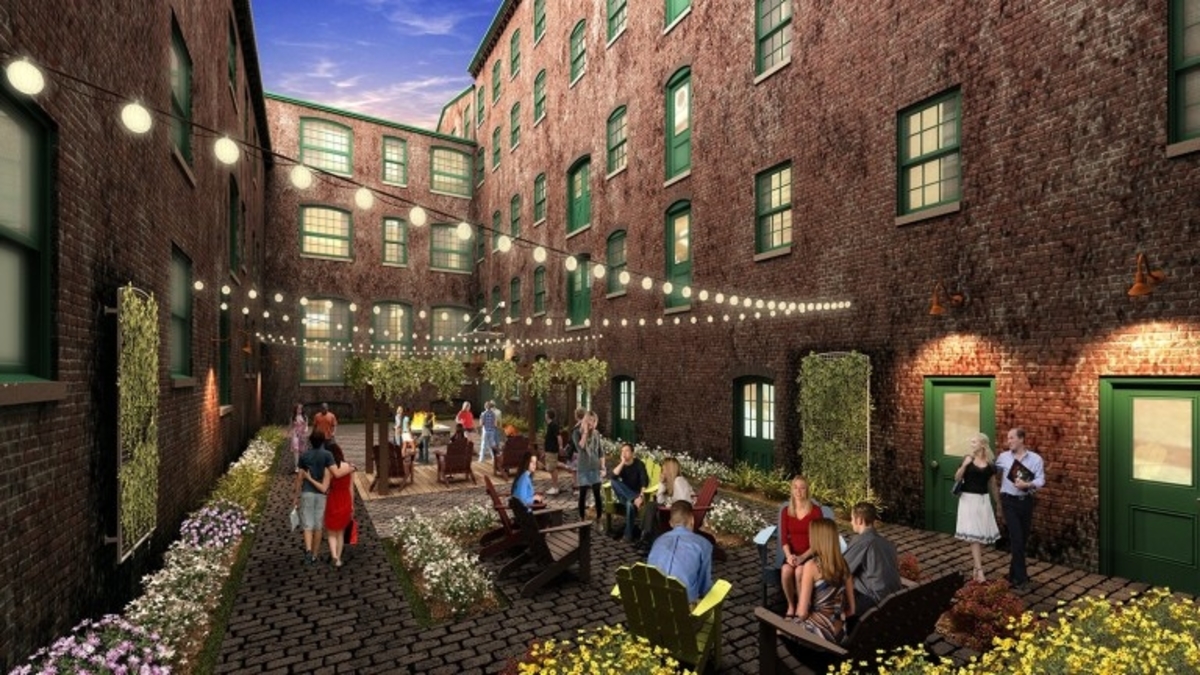Workforce Housing Project Revitalizes Urban Neighborhood

The mission of Oxford Mills — a $38 million historic rehabilitation in Philadelphia’s Kensington neighborhood — was to create a vibrant, synergistic, education-based community of teacher housing and nonprofit organizations.
Comprising two former industrial buildings, this high-density housing project includes 114 apartments that provide much-needed workforce housing and 38,000 square feet of commercial/office space for more than 10 different nonprofit organizations. Ninety of the apartments are rented to residents earning up to 80 percent of the area median income (AMI), with 68 of those reserved for local teachers. The remaining apartments are rented at market rates.
The collaborative, education-centered model for Oxford Mills replicates other similar successful historic rehabilitation projects. Seawall Development’s Donald Manekin developed this model based on his experience as a board member for Teach for America and a two-year stint as interim chief operating officer of the Baltimore school system. Based in Baltimore, Seawall Development partnered with another private developer, D3 Development in Philadelphia, to launch the model there.
Though there was some push back from local residents due to concerns of gentrification, several key strategies were utilized to maintain a sense of community:
- Discounted rents for teachers
- Designated office space for nonprofits and other educational organizations
- Social and professional programming and events
- Community meeting spaces open to the public
How did they do it?
The Oxford Mills project benefited substantially from historic rehabilitation tax credits and $34 million in federal New Market Tax Credits (NMTC) from sources such as the Philadelphia Industrial Development Corporation, Enterprise Social Investment Corporation, and the National Trust Community Investment Corporation. TD Bank was the equity investor for the full NMTC allocation and provided the majority of the remaining financing, including $17.8 million in term debt and $6.3 million in historic tax credit equity. Oxford Mills also benefited from a $500,000 loan from an angel investor with a commitment to socially responsible development.
The South Kensington neighborhood was historically a working-class, industrial area that was a center of the textile industry. As manufacturing moved elsewhere in the latter half of the 20th century, many of the large brick factories became vacant and derelict. The two Oxford Mills buildings, now listed on the National Register of Historic Places, originally were home to the Quaker City Dye Works in the early 20th century. The property had defaulted mortgages and was under foreclosure when D3 acquired it.
Although according to D3’s Greg Hill, “[t]ransforming a 150-year-old industrial building into apartments and offices presents unique design challenges,” rehabilitation of the historic Oxford Mills manufacturing buildings sought to retain many of their vintage features. The apartments have been renovated in an open, modern style, with restored original hardwood floors, exposed brick, large windows, 14-foot ceilings, wood columns and timber framing. Units for income-qualified residents are indistinguishable from the market-rate units.
Careful documentation of existing and proposed conditions was required to ensure eligibility for the federal historic rehabilitation tax credits. The project involved over 30 different window and door types in addition to the restoration of the wood flooring, brick and timber framing.
Meeting building accessibility and energy-efficiency requirements posed additional challenges. The historic preservation standards would not allow insulation of the historic exterior brick walls, so instead, energy efficiency was leveraged with new insulation at the roof and high efficiency variable refrigerant flow (VRF) heating and cooling systems.
The many features that Oxford Mills incorporates to serve the educators and educational nonprofits – both design elements and programmatic features – serve the property well to create a thriving community. The success of the Oxford Mills rehabilitation, in turn, has supported revitalization of the surrounding neighborhood.
Key factors for success
- Successful partnership of mission-driven private developers
- Workforce housing for an underserved market
- Creative financing of affordable housing with New Market Tax Credits
- Attractive rehabilitation and conversion of a formerly derelict industrial property
- A successful model for development replicable across different markets
- Neighborhood revitalization
For more housing affordability resources, including the full case study on Oxford Mills, visit nahb.org/housingforall and the Land Use 101 toolkit at nahb.org/lu101. The toolkit also includes access to the full report, How Did They Do It? Discovering New Opportunities for Affordable Housing.
Deborah L. Myerson, AICP — author of the How Did They Do It? Report — contributed to the content of this article. Myerson is an urban planner with 20 years of experience in housing, community development, land use and transportation policy, and urban revitalization.
